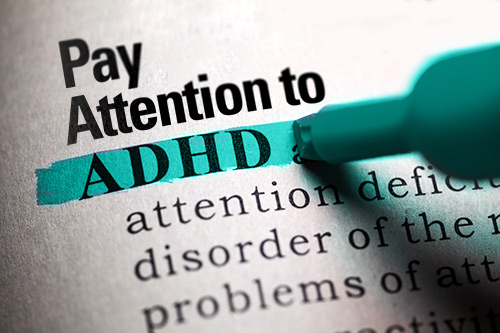Recognizing the Behavior, Managing the Disorder.
Most people can say they have days when either they or their children are forgetful, disorganized or unable to focus. But if you often feel overwhelmed by responsibilities and feel as though you make a lot of mistakes, you may be experiencing adult attention-deficit/hyperactivity disorder (ADHD). While symptoms can be frustrating, the disorder is not at all uncommon: About 11 percent of children and 4 percent of adults have ADHD, according to the organization Children and Adults with Attention-Deficit/Hyperactivity Disorder.
Diagnosing the condition is the first step. “In both adults and children, there are three components to ADHD — hyperactivity, inattention and impulsiveness — that health care providers consider when diagnosing and treating the disorder,” said Lori-Anne Schulte-Laird, a nurse practitioner with clinical expertise in psychiatry.
While not everyone diagnosed with ADHD has symptoms related to all three components, the disorder tends to impact all aspects of life: work, school and home. If either you or your child is exhibiting symptoms, it’s important to remember that you can manage the condition and live a normal, healthy life with help from a MetroHealth expert.
Symptoms in Children
 Children love to stay moving, yet children with ADHD tend to be hyperactive. They may climb on the back of furniture and squirm in their classroom seats above and beyond what is considered typical for kids.
Children love to stay moving, yet children with ADHD tend to be hyperactive. They may climb on the back of furniture and squirm in their classroom seats above and beyond what is considered typical for kids.
Your child may also:
- Make careless mistakes in their schoolwork and have trouble focusing on tests.
- Blurt out answers in the classroom without being called on.
- Cut in line.
- Lack safety awareness (e.g., jumping off the back of the couch without thinking about getting hurt).
- Frequently misplace items such as shoes and backpacks.
- Not complete chores at home.
- Daydream.
Symptoms in Adults
Adults with ADHD often have trouble focusing. They may make excuses for not finishing up projects at work. At home, they may load the dishwasher only halfway or put dinner on the stove but forget to turn on the burner.
Adults with ADHD are also prone to:
- Impulsive spending.
- Repeatedly interrupting conversations.
- Talking quickly.
- Daydreaming.
Diagnosis and Treatment in Children
In children, assessments such as the Vanderbilt Scale help health care providers diagnose the condition. Schulte-Laird has parents and teachers complete the assessment, so she can determine whether ADHD symptoms are occurring both at home and in school. She also observes children in her office to see if they are exhibiting symptoms.
In children under 6, the American Academy of Pediatrics recommends behavioral therapy for treating ADHD. In kids older than 6, behavioral therapy and medication is the preferred approach.
Behavioral therapy includes helping children learn new, positive behaviors to replace those that are causing problems. For example, they may be encouraged to use a fidget tool in the classroom when they are feeling restless instead of moving around in their chair. Parents are also encouraged to help their children manage their behavior [see below for tips].
Medications for ADHD include fast-acting stimulants, which can rapidly improve ADHD symptoms. However, these medications may interfere with sleep, growth and appetite, which is why many health providers prefer prescribing longer-acting, nonstimulant medications that don’t have these side effects.
Diagnosis and Treatment in Adults
Adults concerned about whether they have ADHD should see a primary care physician, a behavioral health professional or a nurse practitioner who can assess their symptoms. Treatment can include behavioral therapy and stimulant medications (adults tend to handle the side effects from these drugs better than children).
How to Help Your Child with ADHD
If you’re a parent of a child with ADHD, you may want to try some of the following strategies:
Create a routine. Keep the same daily schedule, from wake-up to bedtime, to help kids feel comfortable and know what’s expected of them.
Help kids get organized. Put items such as school bags and shoes in a designated place, so children are less likely to lose them.
Manage distractions. Turn off the TV or tablet when it’s time to do homework (keep in mind that some kids with ADHD can better focus while moving and listening to background music).
Limit choices. For example, to avoid your child feeling overwhelmed, give him or her two outfits to choose from instead of ten.
Use clear, brief directions for chores. Be as specific as possible and break down tasks into steps. Instead of, “Please put the milk away and fold the laundry,” try, “Please put the carton of milk that is on the table into the fridge. Then come back to me for instructions about your next chore.”
Use praise as a reward system. Reinforce good behaviors and consider educational rewards like a book or activity they might enjoy.
Provide a healthy lifestyle. Nutritious foods, lots of exercise and good sleep can help your child’s overall well-being.
If you think you or your child may have symptoms of ADHD, talking to your or your child’s primary care provider is the first step.
Find a primary care provider near you
Contributor:

Lori-Anne Schulte-Laird, APRN-CNP
Psychiatry











